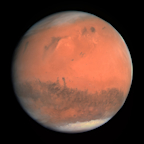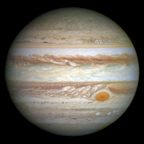Search results
Venus is the second planet from the Sun. It is a terrestrial planet and is the closest in mass and size to its orbital neighbour Earth. Venus is notable for having the densest atmosphere of the terrestrial planets, composed mostly of carbon dioxide with a thick, global sulfuric acid cloud cover.
Jun 3, 2024 · Venus, second planet from the Sun and sixth in the solar system in size and mass. No planet approaches closer to Earth than Venus; at its nearest it is the closest large body to Earth other than the Moon.
Venus is the second planet from the Sun, and the sixth largest planet. It’s the hottest planet in our solar system. Venus is a cloud-swaddled planet named for a love goddess, and often called Earth’s twin. But pull up a bit closer, and Venus turns hellish.
Venus is the second planet from the Sun, and our closest planetary neighbor. It's the hottest planet in our solar system, and is sometimes called Earth's twin.
Jun 13, 2024 · Venus is the hottest planet in our solar system. Venus is a terrestrial planet. It is small and rocky. Venus has a thick atmosphere. It traps heat and makes Venus very hot. Venus has an active surface, including volcanoes! Venus spins the opposite direction of Earth and most other planets. Time on Venus. A day on Venus lasts 243 Earth days. A ...
Feb 26, 2024 · Venus is the brightest planet in our solar system, has a hellish atmosphere, and is covered in volcanoes. Learn more about planet Venus here. Venus: The hot, hellish & volcanic planet : Read...
It's a cloud-swaddled planet named for a love goddess, often called Earth’s twin. But pull up a bit closer, and Venus turns hellish. Our nearest planetary neighbor, the second planet from the Sun, has a surface hot enough to melt lead. The atmosphere is so thick that, from the surface, the Sun is just a smear of light.
Venus is the hottest planet in our solar system. The average surface temperature is 462 °C, and because Venus does not tilt on its axis, there is no seasonal variation. The dense atmosphere of around 96.5 percent carbon dioxide traps heat and causes a greenhouse effect.
The only planet named after a female figure, Venus is a celestial oddball. Though its rocks are shades of grey, its atmosphere imparts an eerie orange glow to the landscape. Together with...
Feb 9, 2022 · NASA’s Parker Solar Probe has taken its first visible light images of the surface of Venus from space. Credits: NASA’s Goddard Space Flight Center/Joy Ng. Download this video and more imagery in HD formats from NASA Goddard’s Scientific Visualization Studio.



















